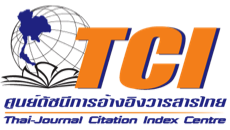JOB SATISFACTION AND WORK-LIFE BALANCE AFFECTING RETENTION OF GENERATION Y SUPPORT STAFF: A CASE STUDY OF THE FACULTY OF DENTISTRY OF A UNIVERSITY IN THAILAND DURING COVID-19 PANDEMIC
DOI:
https://doi.org/10.14456/apsr.2023.6Keywords:
Job Satisfaction, Work-Life Balance, Employee Retention, Generation YAbstract
This study aimed to determine the relationship between job satisfaction, work-life balance, and retention of generation Y support staff during the COVID-19 pandemic in Thailand. The questionnaire used for this study consisted of 4 parts: 1) personal characteristics; 2) job satisfaction; 3) work-life balance; and 4) employee retention. Data for this cross-sectional study was collected between March 10 to April 17, 2022. The study includes 962 participants, of whom 544 were recruited using a stratified sampling method. SPSS version 18 was used to analyze the data, and the statistical analysis included descriptive statistics, Pearson's product-moment correlation, and stepwise multiple regression. The result showed that job satisfaction, work-life balance, and employee retention mean scores were moderate. Age, income adequacy, job satisfaction, and work-life balance significantly correlated with the retention of generation Y staff. Moreover, job satisfaction and work-life balance were statistically significant predictors and predicted 57.1% retention of generation Y support staff. These results suggest that the Faculty of Dentistry should focus on improving job satisfaction and work-life balance for generation Y support staff to prevent them from leaving the organization.
Downloads
References
Alameddine, M., Bou-Karroum, K., Ghalayini, W., & Abiad, F. (2021). Resilience of nurses at the epicenter of the COVID-19 pandemic in Lebanon. International Journal of Nursing Sciences, 8(4), 432-438.
Alrawashdeh, H., Al-Tammemi, A., Alzawahreh, M., Al-Tamimi, A., Elkholy, M., Al-Sarireh, F., Abusamak, M., Elehamer, N., Malkawi, A., Al-Dolat, W., Abu-Ismail, L., Al-Far, A., & Ghoul, I. (2021). Occupational burnout and job satisfaction among physicians in times of COVID-19 crisis: a convergent parallel mixed-method study. BMC Public Health, 21, 811.
Attar, M., Cagliyan, V., & Abdul-Kareem, A. (2020). Evaluating the moderating role of work-life balance on the effect of job stress on job satisfaction. Istanbul Business Research, 49(2), 201-223.
Boamah, S., Hamadi, H., Havaei, F., Smith, H., & Webb, F. (2022). Striking a Balance between Work and Play: The Effects of Work–Life Interference and Burnout on Faculty Turnover Intentions and Career Satisfaction. International Journal of Environmental Research and Public Health, 19(2), 809.
Chen, I., Peng, N., Fuang, N., & Sin, K. (2021). Impacts of job-related stress and patient safety culture on patient safety outcomes among nurses in Taiwan. International Journal of Healthcare Management, 14(1), 1-9.
Daengnoi, C. (2016). The predictive factors of work retention through perception of professional nurses at a private hospital in Bangkok Metropolitan. Master of Nursing Science Thesis, Christian University.
Daniel, W., & Cross, C. (2018). Biostatistics: A Foundation for Analysis in the Health Sciences. 11th ed. New Jersey: John Wiley & Sons, Inc.
De Cooman, R., & Dries, N. (2012). Attracting Generation Y: How Work Values Predict Organizational Attraction in Graduating Students in Belgium. In E. Ng, S. Lyons, & L. Schweitzer. (eds.). Managing the New Workforce: International Perspectives on the Millennial Generation (pp. 42-63). Massachusetts: Edward Elgar Publishing.
Dex, S., & Bond, S. (2005). Measuring work-life balance and its covariates. Work, Employment and Society, 19(3), 627-637.
Elsafty, A., & Oraby, M. (2022). The impact of training on employee retention: An empirical research on the private sector in Egypt. International Journal of Business and Management, 17(5), 58-74.
Falatah, R. (2021). The Impact of the Coronavirus Disease (COVID-19) Pandemic on Nurses' Turnover Intention: An Integrative Review. Nursing Reports, 11(4), 787-810.
Ginting, E., & Meilani, Y. (2022). The Effect of Training and Development, Supervisor Support, and Compensation on Employee Retention during COVID-19 Pandemic on Nurses of X Hospital in Jakarta. Budapest International Research and Critics Institute-Journal, 5(2), 11541-11553.
Greenhaus, J., Collins, K., & Shaw, J. (2003). The relation between work-family balance and quality of life. Journal of Vocational Behavior, 63(3), 510-531.
Hayes, J., Parks, C., McNeilly, S., & Johnson, P. (2018). Boomers to Millennials: Generational Stereotypes at Work in Academic Librarianship. The Journal of Academic Librarianship, 44(6), 845-853.
Herzberg, F. (1966). Work and the Nature of Man. Ohio: World Publishing Company.
Humphries, N., McDermott, A., Creese, J., Matthews, A., Conway, E., & Byrne, J. (2020). Hospital doctors in Ireland and the struggle for work–life balance. European Journal of Public Health, 30(Supplement4), iv32-iv35.
Ibrahim, I. (2021). Factors Effecting Employees Retention in The Malaysian Manufacturing Industry During the Pandemic Covid-19: The Mediating Role of Job Satisfaction. Asian Journal of Research in Business and Management, 3(3), 24-39.
Inda, S., & Mishra, S. (2016). A study on influence of employee compensation, job satisfaction, working environment on employee retention. International Journal of Multidisciplinary Research and Development, 3(7), 103-116.
International Labour Organization. (2021). Teleworking arrangements during the COVID-19 crisis and beyond. Retrieved from www.ilo.org/global/about-the-ilo/how-the-ilo-works/multilateral-system/g20/reports/WCMS_791858/lang--en/index.htm.
Issahaku, J., Nkyi, I., & Dramanu, B. (2020). Impact of work life balance on the psychological wellbeing of employees in the University of Cape Coast. Journal of Psychology & Behavioral Science, 8(1), 8-19.
Jamfung, N. (2018). Development of a Structural Equation Model for a Employee Retention Manual for a Shopping Center Business Based on Constructivism. Doctor of Philosophy Thesis, Srinakharinwirot University.
Kaewtawee, A., & Oumtanee, A. (2014). Relationships between work-life balance, safety climate and organizational commitment of professional nurses, private hospitals, southern region. Journal of The Royal Thai Army Nurses, 15(3), 313-320.
Keith, A., Warshawsky, N., & Talbert, S. (2021). Factors That Influence Millennial Generation Nurses' Intention to Stay: An Integrated Literature Review. Journal of Nursing Administration, 51(4), 220-226.
Mahidol University. (n.d.). Personnel information report Mahidol University. Retrieved from https://muhr.mahidol.ac.th/statistics/index.php.
Management Recruiters International. (2017). 2017 millennial hiring trends study. Retrieved from https://mrinetwork.com/media/303995/2017millennialhiringtrendsstudy.pdf.
National Statistical Office. (2012). Demography population and housing branch. Retrieved from http://statbbi.nso.go.th/staticreport/page/sector/en/01.aspx.
Ramapriya, M., & Sudhamathi, S. (2020). Theory of employee retention strategies. Journal of Interdisciplinary Cycle Research, 12(2), 1112-1118.
Ramey, J. (2021). Adapting to a Changing Landscape: Modifications to a Behavioral Healthcare Agency During COVID-19. Journal of Professional Counseling: Practice, Theory & Research, 48(2), 61-75.
Sanguanpak, S. (2020). Factors affecting turnover intention of generation z professional nurses in a university hospital. Master of Management Thesis, Mahidol University.
Scully, A., Joshi, A., Rector, J., & Eckert, G. (2021). Willingness and ability of oral health care workers to work during the COVID-19 pandemic. Journal of the American Dental Association, 152(10), 791-799.
Sishuwa, Y., & Phiri, J. (2020). Factors influencing employee retention in the transport and logistics industry. Open Journal of Social Sciences, 8(6), 145-160.
Steele-Moses, S. (2021). Predicting medical-surgical nurses’ work satisfaction and intent to stay. Nursing Management, 52(8), 16-25.
Taunton, R., Krampitz, S., & Woods, C. (1989). Manager impact on retention of hospital staff: Part 1. Journal of Nursing Administration, 19(3), 14-19.
Vroom, V. (1964). Work and Motivation. California: Jossey-Bass.
World Economic Forum. (2019). ASEAN Youth: Technology, Skills and the Future of Work. Geneva: Switzerland.
Zhang, X., Lin, D., Pforsich, H., & Lin, V. (2020). Physician workforce in the United States of America: forecasting nationwide shortages. Human Resources for Health, 18, 8.

Downloads
Published
How to Cite
Issue
Section
License
Copyright (c) 2023 Authors

This work is licensed under a Creative Commons Attribution-NonCommercial-NoDerivatives 4.0 International License.











.png)


